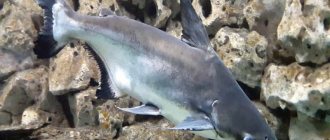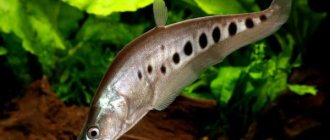The aquarium fish pangasius (Pangasius hypophthalmus), or shark catfish, are delightful and active inhabitants, whose beauty will leave few people indifferent. The second name of the phenotype is decorative shark, since in appearance these charming catfish are similar to sharks - formidable sea predators. Thanks to its bright appearance, pangasius in an aquarium is a stunning sight, but the popularity of the fish was given not only by its external characteristics, but also by the opportunity to keep catfish in an artificial reservoir. To ensure a long and happy life for their pets, lovers of exotic pangasius should be aware of the requirements of fish when keeping them at home.
Description and habitat
Pangasiid catfish are representatives of the Pangasiid family, the order of catfish. The family includes 4 genera and 23 species, but only three are found in the aquarium hobby. In their natural habitat, shark catfish are large and well-fed fish, growing up to 3 m in length, and the body weight of individual giants can reach 300 kg. When kept at home, the Pangasius aquarium catfish has more modest dimensions - the pets do not exceed 1 m in length, but still remain large and massive representatives of the inhabitants of artificial reservoirs.
The rainbow catfish, as this fish is affectionately called, first became known to the world in 1800. The phenotype lives in fresh water. Most shark catfish in their natural environment inhabit the Mekong and Chauh Phraya rivers; much fewer representatives can be found in the rivers of Thailand, Vietnam and Southeast Asia. The appearance of aquarium fish shark catfish is really similar to formidable predators, whose names terrify unwary swimmers, which is why the phenotype received its original name.
Description of fish:
- Flat head, large mouth.
- The body is elongated, torpedo-shaped, slightly compressed at the sides.
- The anal fin is long, fringed.
- The dorsal fin is high, raised up.
Freshwater sharks of mini size for an aquarium behave actively and energetically, never stopping for a minute. Despite such mobility and impressive dimensions, pangasius is a nervous fish that is frightened by loud sounds, unexpected movements of neighbors and the owner behind the glass of the tank. With age, catfish become sedate, fish movements slow down and become stately, and their appearance loses its resemblance to a shark.
Interesting fact: pangasius is a commercial fish, the fillets of which are used for cooking and for sale for export.
Reproduction
In aquarium conditions, cases of fish reproduction are rare. This is due to the fact that due to its large size, without a pond it does not have enough space for full development, and the requirements for spawning grounds for pangasius are high. In industrial ponds, fish are bred normally. Under natural conditions, spawning occurs in late spring and early summer. At this time, the fish move up the river to their permanent spawning grounds.
Fish breed only in industrial ponds and natural environments.
Females spawn in areas with particularly dense vegetation. The fry emerge from the eggs after two days and feed on microplankton.
Sex differences
Outwardly, it is easy to distinguish adult males from females. The female is larger and lighter. In adults, these differences are clearly visible. Young individuals are indistinguishable, so it is not possible to choose a pair from the juveniles when purchasing .
Varieties
The Pangasiidae family includes many varieties, but in the aquarium hobby you can only get acquainted with three species of shark catfish:
- High-finned pangasius (Pangasius sanitwongsei) - representatives are plump in size - up to 1 m in length, and prefer to live in a school of relatives. The color of the scales is dark silver, but the shade becomes lighter with age.
- Siamese pangasius (Pangasionodon hypophthalmus) – when kept at home, Siamese shark catfish stretch up to 60 cm in length. The body of the young fish is smoky-gray, there are 2 silver stripes along the body, and the belly is light. As it matures, the color of Pangasionodon hypophthalmus darkens.
- Small pangasius (Pseudolais pleurotaenia) - in comparison with previous species, the small shark catfish is modest in size, growing only 35 cm in length. Representatives have short antennae and a rich, rich body color - bright silver. They are nocturnal in the aquarium, preferring to hide in shelters during the daytime.
Trends
Aquaculture development of P. hypophthalmus will continue at a moderate pace. The price will remain stable or fall if China solves its problems with the cultivation of this catfish and improves productivity.
However, farming this species is a high-risk endeavor because the returns are low. It is possible that in the medium to long term some fish farmers will begin to exit the industry due to its consolidation. High requirements for the transportation, labeling and certification of fish will entail the development of large enterprises with vertical integration. —— www.fao.org/fishery/culturedspecies/Pangasius_hypophthalmus/en www.seriouslyfish.com/species/pangasionodon-hypophthalmus/
Features of keeping shark catfish
Decorative domestic sharks are a fascinating sight, so many novice aquarists get pangasius for beauty. However, shark catfish, despite its endurance, is not a fish for beginners in aquarium keeping, since the phenotype requires careful care and specific conditions of detention. Before you purchase a pangasius shark catfish, you should find out about the requirements of your future pet:
- Aquarium - shark catfish at a young age look touching, but the fish grow rapidly and reach considerable sizes. In addition, pangasius are school dwellers, and in order for the catfish not to get bored, you will have to buy him 2-3 relatives. To keep fish at home you will need a huge tank - from 800 liters. A lid is required.
- Internal arrangement - pangasius, despite the similarity in sharks, fish with a hysterical character. If you scare your pet, the fish will begin to frantically rush around the tank, knocking down decorations and neighbors. Taking this feature into account, low-growing plants and round flat stones are planted in the reservoir. The middle and upper layers of the water column must remain free for unimpeded movement.
Water parameters:
- Temperature – 22-26C.
- Hardness – 2-29 dH.
- Acidity – 6.5-7.5 pH.
Pangasius fish is an aquarium resident, distinguished by its demands on the aquatic environment. Given the size and gluttony of catfish, the fish leave a lot of dirt and waste, which the owner will have to deal with regularly. In addition, you need to change the water weekly, updating 40% of the volume. The aquarium must be equipped with powerful and high-quality filters and aerators.
The most popular types of aquarium sharks
Pangasianodon hypophthalmus differ not only in appearance from each other, but also in taste preferences, size, habits and character. The most common types of highly finned pangasius:
- Dwarf sharks are small, up to 25 cm. They are a viviparous species, produce offspring of up to 10 sharks, the size reaches up to 6 cm. Aquarists consider them the most popular among decorative aquarium sharks. They love warm water. They have sharp teeth. They love to eat cephalopods. The shark has luminescent organs that glow on the lower and lateral fins and the lower part of the abdomen. With good maintenance, life expectancy is up to 10 years.
- The pennant, freshwater river shark or shark catfish, is the fish that has the greatest external resemblance to the predator. In the natural environment it can reach up to 1.5 m, in domestic ones no more than 60 cm. It has interesting behavior, is very timid and when frightened pretends to be dead, but after 20–30 minutes everything returns to normal. It is not recommended to tease; when irritated, it hits the walls of the aquarium, which can cause damage to itself.
- The black shark is beautiful and graceful. Gluttonous, if it feels that it is not being fed enough, it periodically makes attempts to attack its neighbor in order to feast on it. If something is wrong in the kingdom, she immediately becomes lighter in color. Signaling the owner to find out the reasons why she doesn’t like it. The black bicolor shark is of fantastic beauty, with velvety black skin and a bright red tail. She has an aggressive and capricious character.
- The Colombian shark catfish or silver shark is a unique fish that has echolocation, this is a way of communicating with relatives in turbid water. The upper fins are poisonous, but the poison is not fatal.
Dwarf shark
Pennant shark
Black Shark
Colombian shark catfish
Feeding
The dwarf shark Pangasius has an excellent appetite, and pulls into its mouth everything it can find and swallow. The diet of domestic catfish should be nutritious and varied: shrimp, squid and small fish are suitable as animal products. Pangasius will not refuse both dry food and plant foods.
When feeding fish, it is important to take into account that the shark catfish does not behave like other catfish - the phenotype does not pick up food from the bottom of the reservoir, but feeds while afloat. If there is not enough food, mini-sharks may attack their neighbors.
Interesting fact: as fish age, they lose their teeth and become vegetarians.
production cost
The cost of raising pangasius (P. hypophthalmus) in intensive pond culture is relatively stable, but the profit margin is very small. At the beginning of 2009, fish farmers spent $0.83 per 1 kilogram of fish, excluding capital investments. At the same time, the price on the market was not much more – $0.89 per 1 kilogram. On the other hand, fish processing industries spend $0.78-0.83 per 1 kilogram of imported fish, and their production costs amount to $0.72-0.78 per 1 kilogram excluding capital investments. Most fish farmers view capital investment as a sunk cost. In early 2009, profits were so low that farmers in Vietnam were unable to fully recoup their capital investments.
Compatibility
When introducing shark catfish with other fish, care and caution should be exercised. Despite the fact that pangasius is quite friendly, the fish are still not averse to feasting on their weak and small neighbor. It is recommended to keep catfish in an aquarium along with the following phenotypes:
- Shark ball.
- Parrots, astronotuses, cichlazomas.
- Indian knife.
- Kalamoikhty.
- Polypterus.
Pangasius has negative compatibility with small and phlegmatic fish - the catfish will eat miniature inhabitants, and can destroy slow but large phenotypes during fright.
Reviews
Reviews from aquarists help you learn more about shark catfish and learn from experience in keeping and caring for them.
On occasion, I bought a baby shark catfish at the market. For more than ten years I watched a 40-centimeter pangasius endlessly “cut” circles in an aquarium. At first I fed the fish shrimp, but I realized that keeping it was too expensive. Later, I picked up dry food and gave her fresh vegetables. Friends suggested that you can feed a freshwater shark by hand. Not right away, but I did it. The catfish greedily grabbed pieces from his palm. It all ended tragically. When I left for a long holiday, the filter failed. This was the reason for the death of my catfish. Maria, Moscow
I don't have the best memories of pangasius. The fish is very shy. Due to the stress that even a person passing by causes, the pet rushes about, damages decorations, and breaks thermometers. I was afraid that sooner or later the glass of the aquarium would break. I had to give the fish back to the pet store. And how much excrement we had to clean up after him! Care and maintenance require a lot of effort and time. I do not recommend keeping Siamese pangasius at home. Natalia
Despite its terrifying appearance, pangasius is cowardly and sometimes loses consciousness. The catfish can lie motionless on the bottom for 10 minutes or stick its muzzle into the sand and not move. Then somehow magically it comes to life. It is interesting to watch a school of fish ride on air bubbles. My shark-like catfish got along with barbs and angelfish. Maintenance and care did not burden me. And there were no problems with nutrition, they are omnivores. Nikolay
Breeding
Unfortunately, breeding pangasius at home is impossible. Those representatives that can be seen in stores come for sale from Southeast Asia, where catfish are bred in lakes or containers, stimulating spawning with injections.
The aquarium fish Pangasius is a favorite phenotype of fans of exotic species and the depths of the sea, because in appearance the fish is so reminiscent of formidable sea predators. Keeping shark catfish requires a responsible and serious approach, since space and a clean water environment are important for pets.
Diseases
Pangasius are vulnerable to many common fish diseases, particularly fungal diseases. Like most catfish, if infected with ichthyophthyriasis, treatment is difficult due to the lack of external protection in the form of scales, therefore, when treated with drugs, their concentration should be halved. More information about diseases can be found in the section “Diseases of aquarium fish”.
Peculiarities
- Aquarium at least 400 liters
- Large fish size
- Delicate skin, easily injured











